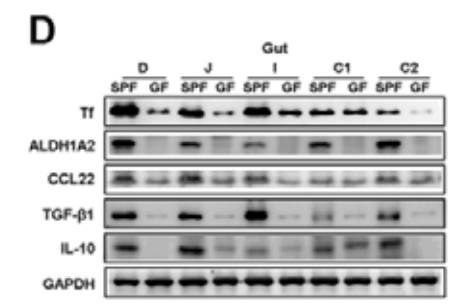ALDH1A2 Antibody - #DF4422
| Product: | ALDH1A2 Antibody |
| Catalog: | DF4422 |
| Description: | Rabbit polyclonal antibody to ALDH1A2 |
| Application: | WB IHC IF/ICC |
| Cited expt.: | WB |
| Reactivity: | Human, Mouse, Rat |
| Prediction: | Pig, Zebrafish, Bovine, Horse, Sheep, Rabbit, Dog, Chicken, Xenopus |
| Mol.Wt.: | 52 KD; 57kD(Calculated). |
| Uniprot: | O94788 |
| RRID: | AB_2836777 |
Related Downloads
Protocols
Product Info
*The optimal dilutions should be determined by the end user. For optimal experimental results, antibody reuse is not recommended.
*Tips:
WB: For western blot detection of denatured protein samples. IHC: For immunohistochemical detection of paraffin sections (IHC-p) or frozen sections (IHC-f) of tissue samples. IF/ICC: For immunofluorescence detection of cell samples. ELISA(peptide): For ELISA detection of antigenic peptide.
Cite Format: Affinity Biosciences Cat# DF4422, RRID:AB_2836777.
Fold/Unfold
AL1A2_HUMAN; Aldehyde dehydrogenase family 1 member A2; ALDH1A2 aldehyde dehydrogenase 1 family, member A2; ALDH1A2; Aldh1a7; AV116159; MGC26444; RALDH 2; RALDH(II); Raldh1; RalDH2; RALDH2 T; Retinal dehydrogenase 2; Retinaldehyde dehydrogenase 2; Retinaldehyde specific dehydrogenase type 2; Retinaldehyde-specific dehydrogenase type 2;
Immunogens
A synthesized peptide derived from human ALDH1A2, corresponding to a region within C-terminal amino acids.
- O94788 AL1A2_HUMAN:
- Protein BLAST With
- NCBI/
- ExPASy/
- Uniprot
MTSSKIEMPGEVKADPAALMASLHLLPSPTPNLEIKYTKIFINNEWQNSESGRVFPVYNPATGEQVCEVQEADKADIDKAVQAARLAFSLGSVWRRMDASERGRLLDKLADLVERDRAVLATMESLNGGKPFLQAFYVDLQGVIKTFRYYAGWADKIHGMTIPVDGDYFTFTRHEPIGVCGQIIPWNFPLLMFAWKIAPALCCGNTVVIKPAEQTPLSALYMGALIKEAGFPPGVINILPGYGPTAGAAIASHIGIDKIAFTGSTEVGKLIQEAAGRSNLKRVTLELGGKSPNIIFADADLDYAVEQAHQGVFFNQGQCCTAGSRIFVEESIYEEFVRRSVERAKRRVVGSPFDPTTEQGPQIDKKQYNKILELIQSGVAEGAKLECGGKGLGRKGFFIEPTVFSNVTDDMRIAKEEIFGPVQEILRFKTMDEVIERANNSDFGLVAAVFTNDINKALTVSSAMQAGTVWINCYNALNAQSPFGGFKMSGNGREMGEFGLREYSEVKTVTVKIPQKNS
Predictions
Score>80(red) has high confidence and is suggested to be used for WB detection. *The prediction model is mainly based on the alignment of immunogen sequences, the results are for reference only, not as the basis of quality assurance.
High(score>80) Medium(80>score>50) Low(score<50) No confidence
Research Backgrounds
Converts retinaldehyde to retinoic acid. Recognizes as substrates free retinal and cellular retinol-binding protein-bound retinal. Can metabolize octanal and decanal, but has only very low activity with benzaldehyde, acetaldehyde and propanal. Displays complete lack of activity with citral (By similarity).
Cytoplasm.
Belongs to the aldehyde dehydrogenase family.
Research Fields
· Metabolism > Metabolism of cofactors and vitamins > Retinol metabolism.
· Metabolism > Global and overview maps > Metabolic pathways.
References
Application: WB Species: Mouse Sample: gut tissue
Restrictive clause
Affinity Biosciences tests all products strictly. Citations are provided as a resource for additional applications that have not been validated by Affinity Biosciences. Please choose the appropriate format for each application and consult Materials and Methods sections for additional details about the use of any product in these publications.
For Research Use Only.
Not for use in diagnostic or therapeutic procedures. Not for resale. Not for distribution without written consent. Affinity Biosciences will not be held responsible for patent infringement or other violations that may occur with the use of our products. Affinity Biosciences, Affinity Biosciences Logo and all other trademarks are the property of Affinity Biosciences LTD.


